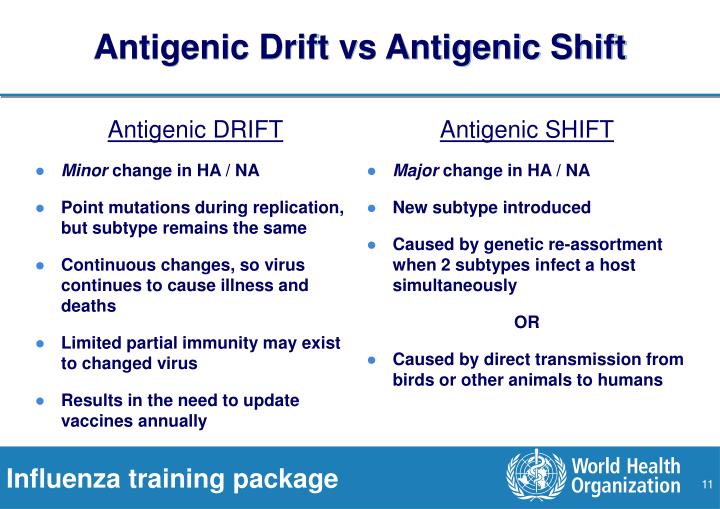

Specifically, 18 specific codons in the HA1 domain of the hemagglutinin gene have been identified as undergoing positive selection to change their encoded amino acid. These dynamic selection pressures facilitate the observed rapid evolution in the hemagglutinin gene. In human populations, immune (vaccinated) individuals exert selective pressure for single point mutations in the hemagglutinin gene that increase receptor binding avidity, while naive individuals exert selective pressure for single point mutations that decrease receptor binding avidity. Antigenic drift is this continuous process of genetic and antigenic change among flu strains. Antigenic drift allows for evasion of these host immune systems by small mutations in the hemagglutinin and neuraminidase genes that make the protein unrecognizable to pre-existing host immunity. Sites recognized on the hemagglutinin and neuraminidase proteins by host immune systems are under constant selective pressure. The hemagglutinin is responsible for binding and entry into host epithelial cells while the neuraminidase is involved in the process of new virions budding out of host cells. In the influenza virus, the two relevant antigens are the surface proteins, hemagglutinin and neuraminidase. A longer epidemic allows for selection pressure to continue over an extended period of time and stronger host immune responses increase selection pressure for development of novel antigens. The rate of antigenic drift is dependent on two characteristics: the duration of the epidemic, and the strength of host immunity. A second type of change is antigenic shift, also discovered by Hilleman, where the virus acquires a completely new version of one of its surface-protein genes from a distantly related influenza virus. In 1940s, Maurice Hilleman discovered antigenic drift, which is the most common way that influenza viruses change. If one of these new forms of an antigen is sufficiently different from the old antigen, it will no longer bind to the antibodies or immune-cell receptors, allowing the mutant virus to infect people who were immune to the original strain of the virus because of prior infection or vaccination. However, viral genomes are constantly mutating, producing new forms of these antigens. After an infection or after vaccination, the body produces many more of these virus-specific immune receptors, which prevent re-infection by this particular strain of the virus this is called acquired immunity.

This recognition is quite precise, like a key recognizing a lock. These receptors can be antibodies in the bloodstream or similar proteins on the surfaces of immune-system cells. The immune system recognizes viruses when antigens on the surfaces of virus particles bind to immune receptors that are specific for these antigens. Genetic drift is very different and much more broadly applicable it refers to the gradual accumulation in any DNA sequence of random mutational changes that do not interfere with the DNA's function and thus that are not seen by natural selection.) Antigenic shift is a closely related process it refers to more dramatic changes in the virus's surface proteins. (Confusion can arise with two very similar terms, antigenic shift and genetic drift. Antigenic drift occurs in both influenza A and influenza B viruses. This makes it easier for the changed virus to spread throughout a partially immune population. This results in a new strain of virus particles that is not effectively inhibited by the antibodies that prevented infection by previous strains.
ANTIGENIC SHIFT CODE
Not to be confused with Antigenic shift or Genetic drift.Īntigenic drift is a kind of genetic variation in viruses, arising from the accumulation of mutations in the virus genes that code for virus-surface proteins that host antibodies recognize.


 0 kommentar(er)
0 kommentar(er)
